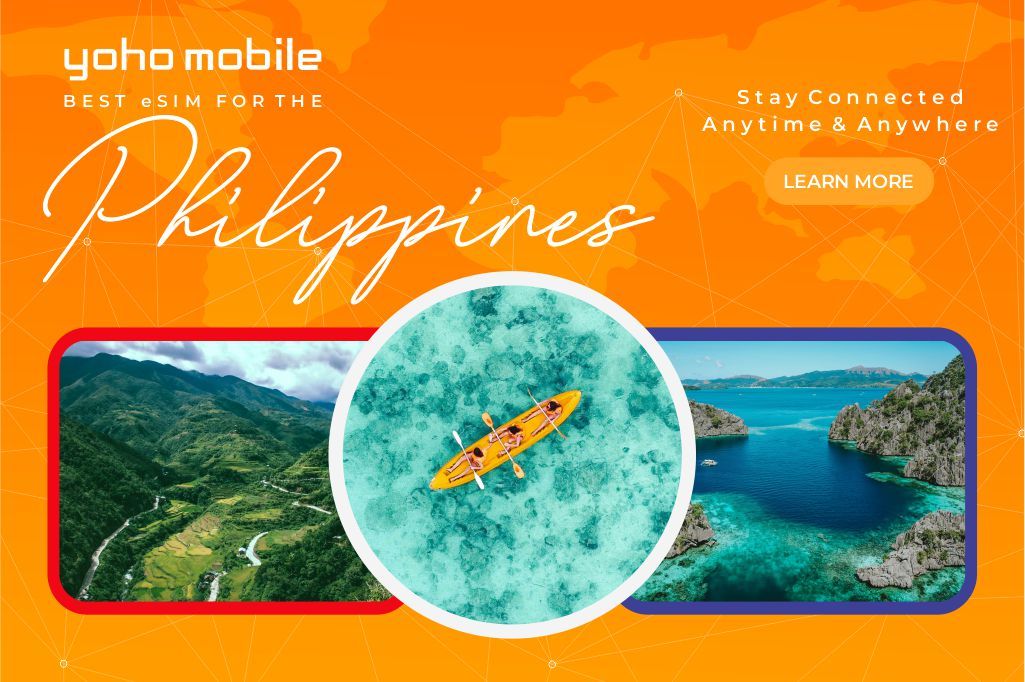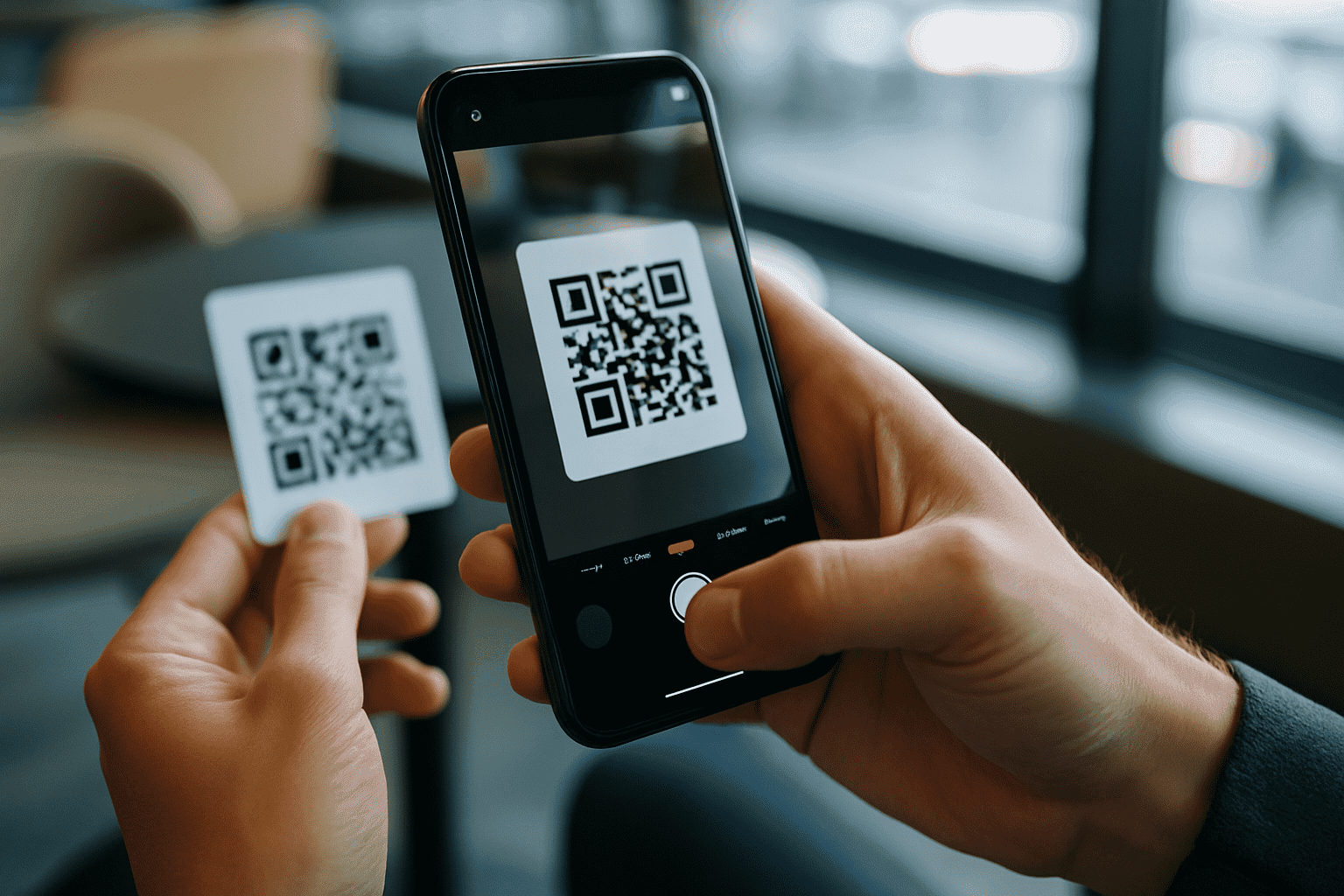如果你要去菲律宾,你会希望保持联网。没有互联网,很难获取路线、预订乘车或与人沟通。
购买当地 SIM 卡可能很麻烦且耗时。eSIM 使这变得更容易。它让你无需实体 SIM 卡即可使用本地数据。在本指南中,我们将解释什么是 eSIM、它是如何工作的,以及为什么它可能是你菲律宾之行的最佳选择。

什么是 eSIM 及其工作原理?
借助 eSIM 技术,旅行期间保持联网现在变得更加简单。eSIM (嵌入式 SIM 卡)是一种已内置于你设备中的数字 SIM 卡。这意味着你不再需要实体 SIM 卡。无需寻找商店并更换小卡片,只需几分钟即可激活 eSIM。通常,只需扫描二维码或输入一些激活详情。
与传统 SIM 卡不同,eSIM 允许你轻松切换移动网络。这对于需要可靠互联网的旅行者来说非常完美。在菲律宾,办理本地 SIM 卡有时可能涉及文书工作或排队。eSIM 提供了一种轻松联网的方式。此外,没有丢失小型 SIM 卡的风险,而且你通常可以进行数字管理。它正成为国际旅行者的首选。
选择 eSIM 和普通预付 SIM 卡取决于你旅行的需求。你还可以查看这篇关于国际漫游与 SIM 卡的文章,了解更多详情。
如何选择最适合菲律宾的 eSIM?
无论你旅行到哪里都会有信号吗?
菲律宾是一个拥有 7,000 多个岛屿的群岛,并非所有 eSIM 都提供相同的覆盖范围。如果你主要停留在马尼拉、宿务市或达沃等主要城市,大多数 eSIM 都能提供良好的服务。
但是,如果你的计划包括探索巴拉望岛、锡亚高岛或吕宋岛北部等更偏远的岛屿,你会需要与菲律宾主要运营商(如 Globe 或 Smart)合作的 eSIM。购买前查看提供商的覆盖地图总是一个好主意,以避免意外。
你到底需要多少数据?
你的数据需求取决于你使用手机的方式。对于使用地图、查收电子邮件和轻度浏览等简单任务,每周 1GB 到 3GB 应该足够了。如果你计划流媒体视频、定期使用社交媒体或进行视频通话,可以考虑两周行程选择 5GB 到 10GB 套餐。对于远程工作或大量使用云存储的人来说,最好选择无限套餐或至少 20GB 包月套餐。
专业提示: 许多提供商允许你轻松充值数据(如果流量不足),因此你可以先选择较小的套餐,如有需要再添加!
你旅行的时长是多久?
eSIM 套餐具有不同的有效期。对于短途旅行,比如 2-3 天,1GB 到 3GB 的套餐通常足以满足导航、信息发送和一些社交媒体使用。如果你停留 4-7 天,5GB 到 10GB 的套餐可能涵盖更活跃的使用,包括一些流媒体。对于两周或更长时间的旅行,20GB 甚至无限套餐将为你提供不间断的数据访问,让你无后顾之忧。
需要语音和短信,还是只需要互联网?
你会发现的大多数菲律宾 eSIM 套餐都是纯数据套餐。这对于旅行 eSIM 来说很常见。对于通话和短信,你通常会使用基于互联网的应用程序,如 WhatsApp、Facebook Messenger、Viber 或 FaceTime。这些应用程序使用你的数据进行通信。然而,少数提供商可能会提供包含菲律宾本地电话号码的特殊套餐,用于传统通话和短信。你也可以查看本指南,了解更多关于最适合通话和短信的 eSIM 的信息。
你需要 eSIM 热点吗?
如果你正在考虑与笔记本电脑、平板电脑或朋友手机等其他设备共享互联网连接,请确保你的 eSIM 提供商允许热点使用。一些 eSIM 套餐限制共享连接(即网络共享)。如果你依赖移动热点工作或与他人一起旅行,购买前请仔细检查此功能。
哪种套餐最划算?
eSIM 的价格各不相同。它们取决于提供商、包含的数据量以及套餐的有效期。对于预算有限的旅行者,你通常可以找到包含几 GB 数据的一周短途套餐,起价约为 5 到 7 美元。如果你需要大量数据用于工作或流媒体,高端无限套餐提供可靠且快速的连接,尽管它们会更贵。比较几种方案以找到最符合你需求的价值总是明智的。另外,请留意促销优惠或捆绑折扣,这可以帮助你节省一些钱。
2025 年菲律宾最佳 eSIM 提供商
选择合适的 eSIM 提供商对于菲律宾无忧旅行至关重要。每个提供商都提供不同的服务,因此让我们在 2025 年旅行时更详细地了解一些热门选项:
Yoho Mobile
Yoho Mobile 因其灵活的套餐和具有竞争力的价格而在前往菲律宾的旅行者中脱颖而出。你可以通过选择所需的精确天数和预计使用的数据量来定制你的套餐。例如,你可能会找到一个提供 1GB 数据为期 7 天的套餐,仅需 2.38 美元,或者如果你计划在同一时间内使用更多互联网,一个更大的 10GB 套餐可能大约 9.71 美元。这意味着你只为你真正需要的付费。
在网络质量方面,Yoho Mobile 连接到菲律宾强大的本地运营商,让你能够访问可用的 4G 和可靠的 5G 网络。这确保了在城市和许多旅游景点浏览、使用地图和流媒体的良好速度。热点共享功能包含在内,如果你想与平板电脑、笔记本电脑或旅伴共享连接,这是一大优势。他们的客户支持通常提供 24/7 服务并支持多种语言,可通过其专用的 iOS 和 Android 应用或网站轻松联系。支付也通过多种选项变得更加容易。

Flexiroam
Flexiroam 是一个知名品牌,特别是如果你的菲律宾之行是更广泛的跨多个国家旅行的一部分(因为他们的许多 eSIM 套餐提供全球或区域覆盖)。对于菲律宾,你可以找到像一周 1GB 数据 8 美元这样的套餐,使用可靠的 4G 网络,确保在城市中心有良好的连接。他们也支持热点使用,所以共享数据是一个选项。虽然对于多国旅行很方便,但他们针对单个国家(如菲律宾)的套餐有时可能比其他专注于本地套餐的提供商稍贵。如果你选择他们的无限数据套餐之一,请注意,一旦你在一天内使用一定量的数据(例如 3 GB 后),你的下载速度可能会降低。客户支持可通过电子邮件和聊天获得。
Jetpac
Jetpac 旨在提供简单且通常经济实惠的 eSIM 套餐,这对于在菲律宾寻求直接解决方案的旅行者来说具有吸引力。你可以找到像 3GB 数据套餐(有效期一周)这样的选项,非常适合短途旅行,只需 7 美元。他们通常使用 4G 网络,在大多数热门地区和旅游目的地提供稳定的互联网连接。热点功能通常也支持,如果你需要连接其他设备,这很方便。需要考虑的一点是,Jetpac 目前不提供无限数据套餐。因此,如果你是一个非常重度的数据用户,经常流媒体大量视频或在线工作,你可能需要考虑其他选项或准备充值。客户支持通常在标准工作时间提供。
Saily
Saily 通常以其经济实惠的短期 eSIM 套餐而闻名,这使其成为快速访问菲律宾的游客的热门选择。例如,你可以获得一个设计为期 7 天的 1GB 套餐,价格为 3.99 美元,这给了你充足的时间使用数据。这些套餐通常运行在可靠的 4G 网络上,通常包含热点功能,允许你共享连接。虽然 Saily 为许多旅行者提供了良好的价值,但关键一点是你必须使用 Saily 应用程序来激活和管理你的 eSIM。这可能不适合所有人,特别是如果你更喜欢通过网站处理事情或手机上没有足够的空间安装新应用。对于客户协助,他们提供实时聊天支持,大多数用户反映他们的问题得到快速解决,体验良好。
Airhub
Airhub 通常吸引那些将菲律宾作为多国旅行(特别是在亚洲)中途一站的旅行者,因为他们专注于多国 eSIM 套餐。你可能会找到一个提供 12GB 数据(有效期一个月)20 美元的套餐,他们通常支持可用的 4G 和快速 5G 网络,确保良好的浏览速度。热点共享功能也通常可用,如果你需要保持多个设备连接,这是一个不错的选择。选择套餐时,你会发现 Airhub 的选项通常是预定义的,这意味着你从设定的数据量和有效期中选择。与一些其他提供商相比,这可能意味着在根据非常具体的需求定制套餐方面灵活性较小。用户通常通过 Airhub 的网页门户而不是移动应用管理其套餐。客户支持通常可通过实时聊天和电子邮件获得。
如何购买并激活菲律宾 eSIM
获得你的菲律宾 eSIM 很简单。这是一个逐步指南,助你联网:

步骤 1:选择你偏好的 eSIM 提供商
首先,确保你的智能手机可以使用 eSIM。许多现代手机都支持,但最好还是仔细检查一下。你可以在此处查看 eSIM 兼容设备列表。Yoho Mobile 是一家值得信赖的提供商,在菲律宾提供良好的覆盖。查看他们的套餐,找到完全符合你旅行需求的套餐。
步骤 2:前往 Yoho Mobile 商店
你可以轻松访问 Yoho Mobile 网站 浏览他们的 eSIM 选项。或者,如果你使用的是 iPhone,可以直接从 App Store 下载 Yoho 应用;对于 Android 设备,可以从 Google Play Store 下载。这使得查看可用套餐和购买变得快速简便。
步骤 3:选择你的目的地
在网站或应用中,选择菲律宾作为你的目的地国家。如果你的探险包括探索东南亚附近的其他国家,如泰国或马来西亚,你可能想考虑区域性多国套餐。这样,一个 eSIM 就可以让你在不同地方保持联网。
4:定制你的 Yoho Mobile 套餐
现在是时候选择一个适合你在菲律宾停留时间和你认为需要多少数据的套餐了。以下是一些通用建议:
- 短途停留(1-3 天): 大约 3GB 数据的套餐通常非常适合基本需求,如使用地图、发送消息和轻度互联网浏览。
- 较长旅行(5-10 天): 如果你会使用社交媒体、流媒体音乐或视频,或进行视频通话,10GB 套餐甚至无限套餐会更适合你。
- 商务旅行或重度使用: 对于需要不间断上网工作或你是重度数据用户的情况,无限数据套餐通常是最方便的选择。
步骤 5:购买你的 eSIM
选择好套餐后,你可以在网站或应用中完成购买:
-
仔细输入你的电子邮件地址。Yoho Mobile 将把你的 eSIM 激活详情发送到此地址。
-
留意是否有促销代码可以省钱,例如使用 YOHO12 可享受所有购买 12% 的折扣。
-
选择你偏好的支付方式。Yoho Mobile 通常接受各种选项,如信用卡和其他常用的在线支付服务。输入你的详细信息以完成交易。
-
如果你想先试用,可以尝试Yoho Mobile 的免费 eSIM 试用,并立即在全球大多数国家获得移动数据访问。没有 SIM 卡,没有合同——只需快速设置,几分钟内即可在线。如果你之后想购买 eSIM 套餐,结账时使用代码 YOHO12 可享受 12% 的折扣!
步骤 6:安装并激活你的 eSIM
购买完成后,你会收到 Yoho Mobile 发来的一封电子邮件。这封电子邮件将包含一个二维码,你将用它来激活你的 eSIM。具体方法如下:
- 确保你的手机连接到稳定的 Wi-Fi 网络。
- 打开手机的“设置”,进入“网络/蜂窝移动网络”(或类似选项),轻点“添加 eSIM”或“添加流量套餐”。扫描提供的二维码或根据需要手动输入激活码。
- 将 eSIM 设置为默认数据 SIM 卡,并打开“数据漫游”。按照屏幕上的提示完成设置——eSIM 将自动激活,你将看到 Yoho Mobile 信号。
安装过程中,请勿删除 eSIM、关闭手机或断开 Wi-Fi 连接。
对于 iPhone 用户: eSIM 会自动安装,无需扫描或手动输入。
你可能还会觉得了解如何使用 Yoho Mobile 创建个性化 eSIM 套餐很有帮助。
在菲律宾使用 eSIM 值得吗?
当然值得!如果你计划前往美丽的菲律宾群岛旅行,eSIM 是保持轻松、经济地联网的绝佳方式。这意味着你可以省去抵达时寻找当地 SIM 卡的麻烦,并避免来自国内提供商的高昂漫游费用。使用 eSIM,你可以获得可靠的互联网访问,在许多地区甚至可以达到快速的 4G 和 5G 速度,无论你是在繁华的马尼拉探险,还是在长滩岛的海滩放松,亦或是在探索隐藏的瑰宝。它只会让你的旅行体验更顺畅,让你能够专注于享受你的探险,并通过手机即时联网的便利。

Photo by John Hernandez on Unsplash
关于在菲律宾使用 eSIM 的常见问题
我的菲律宾之行需要多少数据?
你需要多少数据确实取决于你将在线做什么。如果你主要需要数据用于查看地图、发送几条消息和轻度浏览,每周大约 3GB 到 5GB 应该绰绰有余。如果你喜欢在社交媒体上分享照片、流媒体音乐或进行视频通话回家,两周时间你可能需要考虑 10GB 到 15GB 的套餐。对于在旅行期间工作或流媒体大量视频的人来说,无限数据套餐通常是最好且最无忧的选择。
菲律宾支持 eSIM 技术吗?
是的,当然支持!菲律宾对 eSIM 的支持很好,特别是其主要移动网络,如 Globe 和 Smart。这意味着你在马尼拉和宿务等大城市以及许多热门旅游目的地和岛屿都能获得强大可靠的覆盖。
我可以用菲律宾 eSIM 进行普通电话通话和发送短信吗?
你会发现的大多数菲律宾 eSIM 套餐都是纯数据套餐。这对于旅行 eSIM 来说很常见。对于通话和短信,你通常会使用基于互联网的应用程序,如 WhatsApp、Facebook Messenger、Viber 或 FaceTime。这些应用程序使用你的数据进行通信。然而,少数提供商可能会提供包含菲律宾本地电话号码的特殊套餐,用于传统通话和短信。你也可以查看本指南,了解更多关于最适合通话和短信的 eSIM 的信息。
在菲律宾使用哪种 eSIM 最好?
“最好”的 eSIM 实际上取决于你的个人旅行风格和需求:
- Yoho Mobile: 是前往菲律宾寻找经济实惠且可以根据旅行时长和数据使用量定制套餐的旅行者的首选。
- Flexiroam: 如果你是经常旅行且需要的 eSIM 不仅在菲律宾而且在许多国家都可用,这是一个不错的选择,尽管对于单国使用可能稍微贵一些。
- Jetpac: 对于在菲律宾短期停留来说是一个可靠且预算友好的选择,但请记住他们不为重度用户提供非常大的数据套餐。
